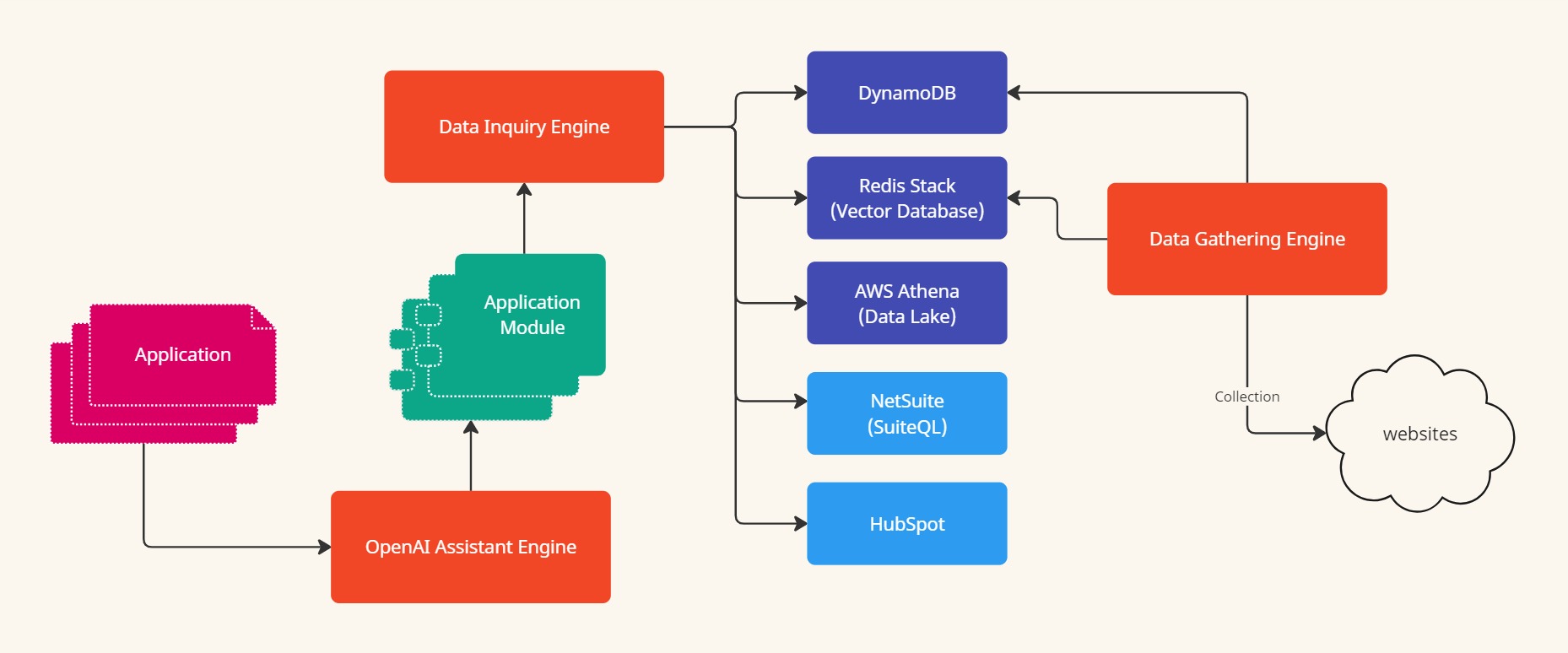Introduction
In an era where digital transformation defines competitive advantage, the integration of AI technologies into business processes has become imperative. At the heart of this innovation lies OpenAI’s Assistant API, which leverages the capabilities of GPT, embedding models, and audio models to deliver intelligent, user-centric applications. By harnessing these advanced tools, businesses can optimize operational efficiency, boost customer engagement, and drive unparalleled growth.
In this blog post, we explore how these technologies are implemented across various domains, enhancing customer experiences, streamlining operations, and enabling advanced analytics.
Technical Architecture
To create cutting-edge applications that integrate OpenAI technologies, we rely on a robust technical framework comprising several key components:

Data Gathering Engine
A high-performance module designed for efficient data collection from both external and internal sources. This engine powers the seamless acquisition of structured and unstructured data, ensuring a consistent feed for downstream applications.
Data Inquiry Engine
This module assembles data inquiry requests and interacts with various sources to retrieve relevant information efficiently. It serves as the backbone of data-driven applications, enabling customized and dynamic data access.
Application Modules
Specialized modules inherit the capabilities of the Data Inquiry Engine, enabling application-specific data processing. These modules cater to a wide range of business needs, from personalized recommendations to advanced analytics.
OpenAI Assistant Engine
The centerpiece of our architecture, the OpenAI Assistant Engine, integrates seamlessly with the Assistant API. It dynamically imports application modules, tracks user interactions, and personalizes responses, creating an adaptive and intuitive user experience.
Applications of OpenAI Technologies
1. Data Crawling and Collection
- Automated Web Scraping: Using Python Scrapy, we extract data from top eCommerce platforms and individual websites. This robust data collection strategy supports detailed analysis of product ratings and user reviews.
- AI Data Processing: Summarization, classification, and tagging capabilities streamline data categorization and enhance accessibility.
2. Vector Database and Advanced Search
- Vector Database Construction: Redis Stack, integrated with the OpenAI embedding model, enables the creation of a high-performance vector database.
- Conversational Search: Leveraging the Assistant API, we provide interactive, natural language-based search capabilities, redefining user interactions.
3. Personalization and Recommendations
- AI-Powered Suggestions: Personalized recommendations based on user behavior and preferences drive customer engagement.
- Storefront Recommendations: Tailored product suggestions, leveraging formula-based matching, enhance customer satisfaction and simplify inquiries.
4. AI-Powered Lead Matching and Networking
- Lead Matching Capabilities: Advanced tools help users identify and connect with potential leads. Features like one-on-one meeting scheduling further streamline engagement.
5. Price Inquiry and Negotiation Tools
An AI-powered chatbot handles price inquiries and negotiations, offering historical data insights and facilitating seamless transactions. These tools streamline price discussions and close transactions efficiently.
6. Advanced Quality Assurance and Master Product Configuration
- Product Categorization: AI tools automate product categorization and dynamic pricing, ensuring consistency and efficiency.
- Quality Assurance Workflow: AI-driven quality checks enhance product standards.
7. Marketing and Campaign Optimization
- AI-Powered Marketing Tools: Utilizing GPT models, personalized marketing campaigns target individuals with tailored content, increasing campaign ROI.
8. AI-Driven Customer Service
- Knowledge Base Integration: A chatbot, backed by a vector database, delivers prompt and accurate support. Audio models further enhance the mobile app experience with voice-based interactions.
9. Advanced Analytics and Recommendations
- Predictive Insights: OpenAI’s code interpreter is employed for regression analysis and trend forecasting.
- Model Training: PyTorch serves as an alternative for custom model training.
Transforming Business with AI
By leveraging OpenAI’s Assistant API and its suite of models, businesses can redefine customer experiences, streamline operations, and unlock new revenue streams. The integration of conversational AI, embedding models, and audio technology ensures a competitive edge, delivering innovation that resonates with modern consumers.
Conclusion
The integration of OpenAI’s GPT, embedding, and audio models offers a transformative approach to building applications that cater to the diverse needs of modern businesses. By adopting this cutting-edge technology, organizations can ensure sustainable growth, enhanced customer satisfaction, and operational excellence.
Stay tuned for more insights on how AI continues to reshape the business landscape!



